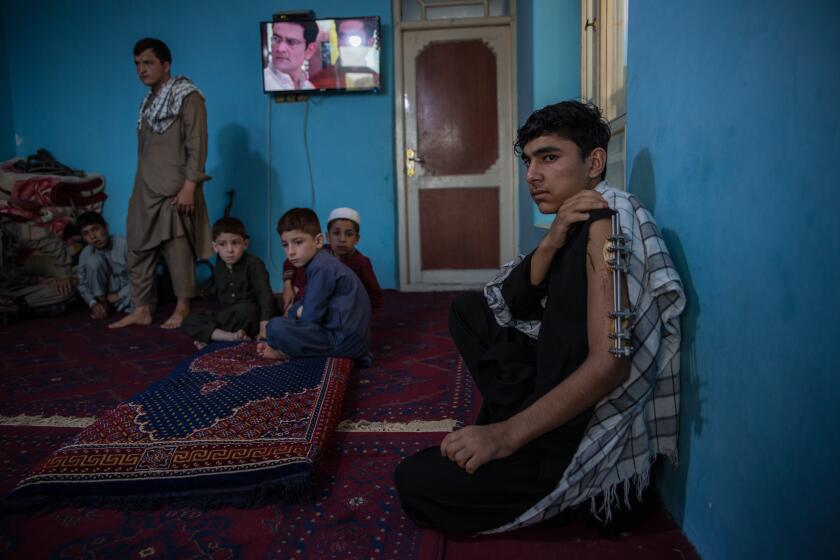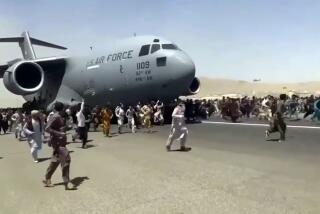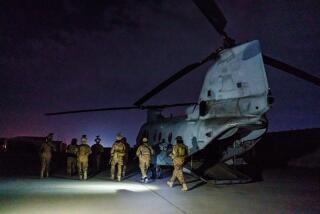Trump cancels U.S. meeting with Taliban and Afghanistan president
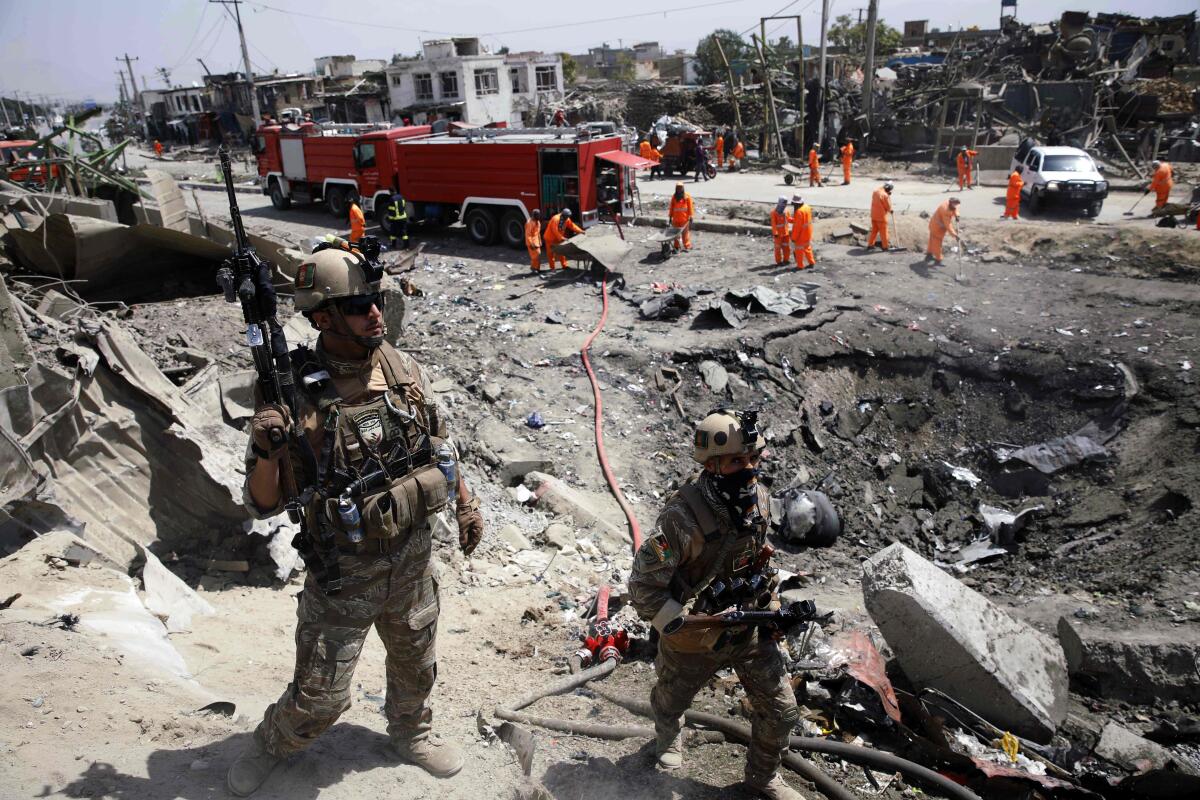
- Share via
WASHINGTON — President Trump said Saturday he was canceling negotiations with the Taliban that could have paved the path toward a withdrawal of U.S. troops from Afghanistan, blaming the decision on a car bombing Thursday by the Islamic militant group that killed 12 people, including an American soldier, in Kabul.
“What kind of people would kill so many in order to seemingly strengthen their bargaining position?” Trump tweeted. “They didn’t, they only made it worse! If they cannot agree to a ceasefire during these very important peace talks . . . then they probably don’t have the power to negotiate a meaningful agreement anyway.”
Trump disclosed that he had secretly sought to arrange a meeting on Sunday with Taliban leaders and Afghan President Ashraf Ghani at Camp David, the presidential retreat in Maryland, but the proposed sit-down was called off.
Even if it had succeeded, the summit would have been politically fraught. Next week marks the 18th anniversary of the Sept. 11 attacks by Al Qaeda, the terrorist group that the Taliban sheltered in Afghanistan before U.S. forces ousted them from power in an invasion.
In any case, it appeared that Trump scrubbed the Camp David meeting after negotiations had already hit a major roadblock. Ghani has expressed strong opposition to the proposed plan, and reports from Kabul last week said he had canceled a planned trip to Washington. It wasn’t known if the Taliban had agreed to come.
The U.S.-Taliban peace talks began in January in the Persian Gulf state of Qatar, and Trump may yet restart them. In 2018, he canceled a planned trip to Singapore to meet North Korea’s ruler for the first time only to reverse himself and go ahead with the trip.
Trump has been eager to pull out of Afghanistan, repeatedly saying a partial pullout was all but assured. But on Saturday he suggested he was prepared to keep fighting America’s longest-ever war, and questioned whether the Taliban would as well.
“How many more decades are they willing to fight?” he tweeted.
A durable peace agreement was hardly a certainty before Trump’s announcements on Saturday.
On Monday, Zalmay Khalilzad, the top U.S. envoy to the peace process, announced in Kabul that an “agreement in principle” had been reached with the Taliban. But he faced stiff pushback from the Afghan government, which feared that a declining American presence would embolden Taliban forces who continue to terrorize the capital and other areas.
A massive car bomb during morning rush hour Thursday killed 12 people, including a Romanian soldier and a U.S. Army paratrooper, near the U.S. Embassy and the NATO mission in Kabul. It brought the number of American military deaths in Afghanistan this year to 16.
“Peace with a group that is still killing innocent people is meaningless,” Ghani said in a statement as at least three car bombs left scores of civilians dead. By Friday, Khalilzad was back in Qatar to talk to the Taliban.
The draft deal would have allowed the Pentagon to withdraw about 5,400 troops by next spring, leaving roughly 8,600 in place. The remaining U.S. forces would support Afghan troops with training, airstrikes and special forces operations, but could be withdrawn in phases if the Taliban met its promises not to allow operations by Islamic State, Al Qaeda or other terrorist groups in areas it controls.
The Taliban has demanded the immediate withdrawal of all U.S. and NATO troops, and it has refused to conduct formal negotiations with Ghani’s government, which it considers illegitimate. The militants also have refused, at least for now, to a cease-fire in a conflict that has seen a surge of both U.S. airstrikes and Taliban attacks this year.
The draft deal reportedly calls for negotiations in Norway between the Taliban and an Afghan delegation that includes government officials. The goal of the Afghan talks would be to negotiate a cease-fire and decide the country’s political future, a far more complicated challenge given the country’s bloody past.
Almost two decades of war have left people on all sides of Afghanistan’s conflict paralyzed with a fear that manifests both mentally and in daily action.
Analysts and Afghan government officials warn that a weak deal could allow the country to backslide into civil war — like the anarchic conflict that raged in the 1990s after Soviet forces withdrew and fueled the Taliban’s rise to power — or again become a haven for terrorist groups like Al Qaeda.
“The people of Afghanistan have been bitten by this snake before,” Waheed Omer, director of public and strategic affairs, told reporters Thursday in Kabul. “They have seen the results of hasty deals, of deals they and their voices weren’t part of.”
The best-case political scenario — some type of eventual power-sharing arrangement between an elected Afghan government and the Taliban — would be a sober reminder of the limitations of U.S. power.
“It’s not going to become Switzerland in the Hindu Kush,” said Luke Coffey, a former U.S. Army officer who served in Afghanistan and now researches foreign policy issues for the Heritage Foundation, a conservative think tank in Washington. “This isn’t defeat. It’s a reality.”
Leon Panetta, who served as Defense secretary under President Obama, described the Trump administration’s talks with the Taliban as “the most screwed-up negotiations I’ve seen take place” and said he doubted they could produce a durable outcome to the conflict.
“If this is just a cover to get the hell out of Afghanistan, I guess that’s one path,” he said. “But if this is a serious effort to produce some stability in Afghanistan, so you’re not going to have another terrorism base created, I think they’re a long way from that result.”
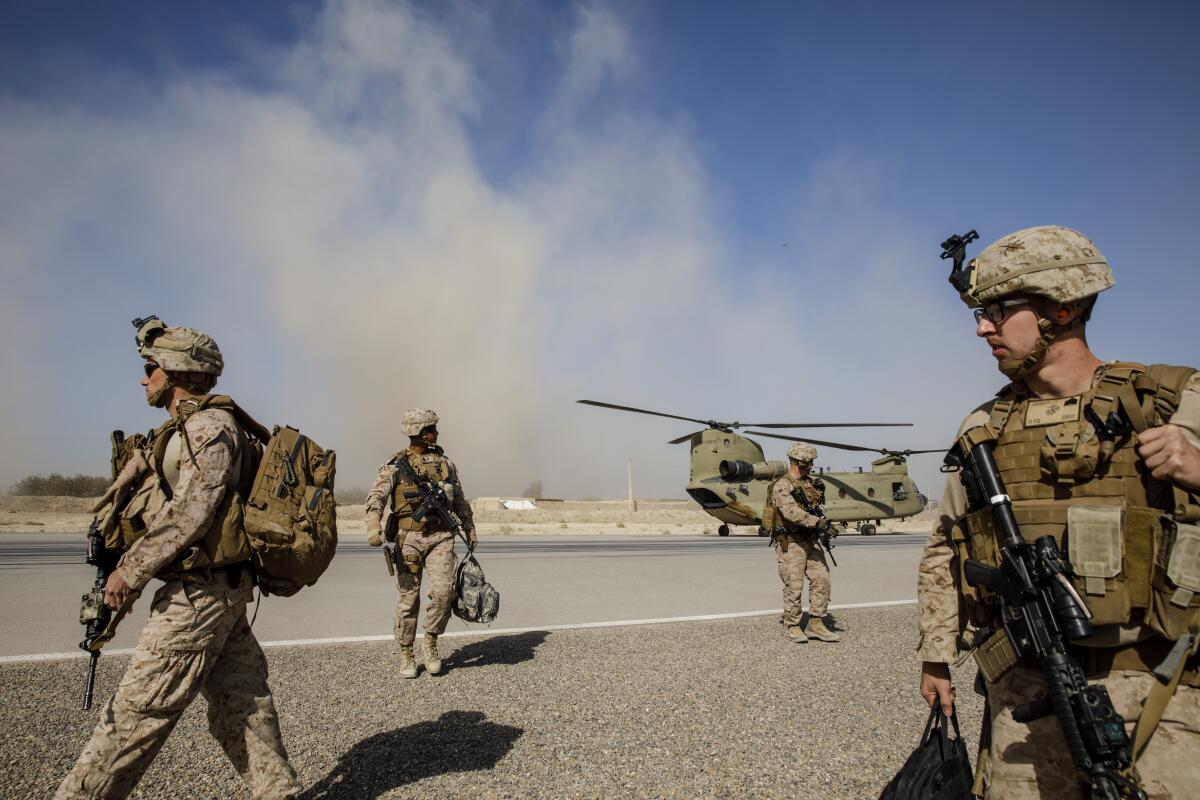
Trump initially wanted to withdraw all U.S. troops, and he once complained that the United States has “wasted an enormous amount of blood and treasure” in Afghanistan. In all, about 2,300 U.S. troops have been killed in the war, and another 20,000 wounded. About 1,100 NATO troops also have been killed.
But after taking office, Trump faced a quandary similar to the one faced by Obama, who balked at a full withdrawal over fears that Afghanistan could spiral into chaos.
Like Obama, Trump instead wound up sending in more forces in his first year, deploying 3,000 extra U.S. troops to bolster Afghan security forces who have struggled to secure the country.
“I hoped that could turn the tide of battle,” said Michael O’Hanlon, a senior fellow at the Brookings Institution, a nonpartisan think tank in Washington. “From what I can tell, it really hasn’t.”
Although Afghan troops have managed to fend off Taliban advances or retake many towns from Taliban control, U.S. officials say the war is at best a precarious stalemate.
The Taliban controls 66 of the country’s 397 districts, most of them in rural, lightly populated areas in the east and south, while the Kabul government controls 138, according to an analysis for the Foundation for Defense of Democracies, a Washington think tank that tracks the conflict.
That leaves 193 districts — nearly half the total — that the foundation describes as “contested.”
The primary role for U.S. forces has been advising and training Afghan troops. But under Gen. Austin “Scott” Miller, the commander of U.S.-led coalition forces in Afghanistan for the past year, they also have increased airstrikes and deployed special operations units to target Taliban leaders as well Al Qaeda and Islamic State forces.
The U.S. and its allies conducted 1,302 airstrikes in the first seven months of 2019, more than any full year since 2013. The goal has been to raise pressure on the Taliban to reach a deal, according to a Pentagon official familiar with the strategy and who spoke on condition of anonymity.
“The conflict continues on,” Secretary of Defense Mark Esper, who briefed allies in Europe this week, told reporters traveling with him. “The [Taliban] are conducting attacks. The Afghans are conducting attacks. We’re supporting Afghan attacks. That’s why we think the best way forward — if we can get the right deal — is a political agreement that leads to a viable outcome.”
U.S. officials say the Taliban isn’t strong enough to immediately threaten Kabul, but Afghan forces have suffered enormous casualties as the U.S. reduced combat operations in recent years, raising fears about how long they could survive without continued U.S. backing. More than 45,000 Afghan security personnel were reported killed between 2014 and 2018.
Trump has been clear about what he wants.
“It’s been a long time. We have great warriors there, we have great soldiers, but they’re not acting as soldiers, they’re acting as policemen and that’s not their job — that’s not their job,” Trump said Wednesday at a White House event. “So, we’d like to get at least a big proportion of them home. We also have NATO troops there. We’d like to bring a big portion of them home. So, we’re talking to the Taliban, we’re talking to the government, we’ll see what happens.”
His focus on pulling out U.S. troops has unsettled some analysts who see the Taliban as trying to take advantage of Trump’s eagerness to withdraw.
“You’re putting a lot on the table right off the bat,” said Seth Jones, director of the transnational threats project at the Center for Strategic and International Studies, a Washington think tank. “That’s not negotiating from a position of strength. You’re already signaling a desire to leave.”
If peace in Afghanistan is possible, he said, it would be contingent on future talks between the government and the Taliban. However, current and former Pentagon officials say they have little expectation that any kind of power-sharing agreement would come together quickly.
Trump faces a tricky path if he brings troop levels down sharply and the war flares up again during his reelection campaign. He then would need to decide whether to send U.S. forces back in to bolster the government.
He has previously pushed for troop withdrawals in Afghanistan and Syria, only to backtrack after advisors warned that insurgent groups could reemerge.
“Trump wants to get out, but even more than that, he probably doesn’t want a great visible catastrophe prior to the election,” sad Jarrett Blanc, a former State Department official responsible for Afghanistan during the Obama administration.
With all those cross-currents, Secretary of State Michael R. Pompeo, in an interview Friday with KAKE-TV in Wichita, Kan., listed Afghanistan as one of the issues that keeps him up at night.
“We want to get that right,” he said. “We have to protect America from terrorism threats, but we’ve had an awful lot of boys and girls killed there and we want to make sure we strike the right balance.”
More to Read
Get the L.A. Times Politics newsletter
Deeply reported insights into legislation, politics and policy from Sacramento, Washington and beyond. In your inbox three times per week.
You may occasionally receive promotional content from the Los Angeles Times.
